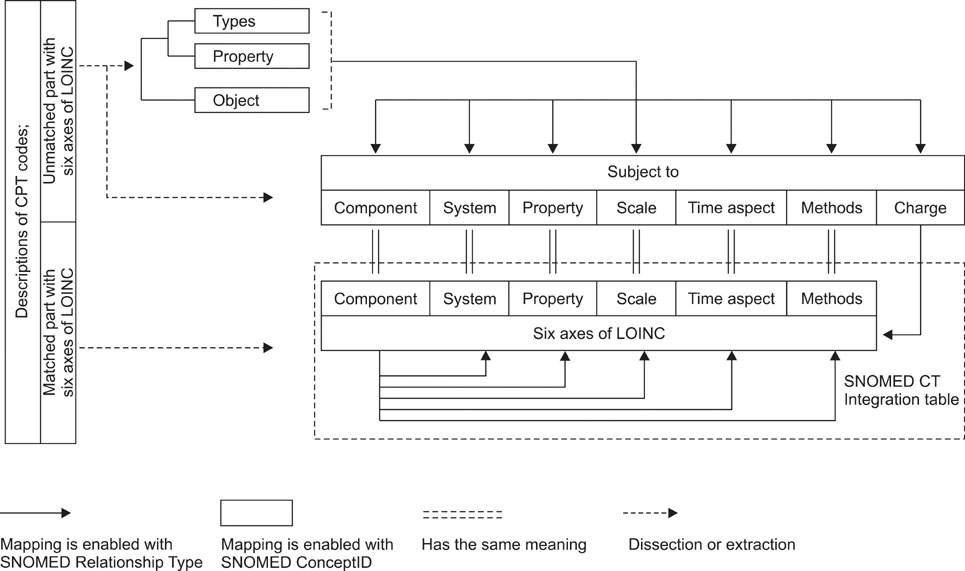Healthc Inform Res.
2010 Sep;16(3):185-190. 10.4258/hir.2010.16.3.185.
Proposed Algorithm with Standard Terminologies (SNOMED and CPT) for Automated Generation of Medical Bills for Laboratory Tests
- Affiliations
-
- 1Department of Laboratory Medicine and Biomedical Informatics, College of Medicine, Pusan National University, Busan, Korea.
- 2MIPTH, Kyungpook National University, Daegu, Korea. pulala@paran.com
- 3Department of Medical Informatics, College of Medicine, Kyungpook National University, Deagu, Korea.
- KMID: 2284531
- DOI: http://doi.org/10.4258/hir.2010.16.3.185
Abstract
OBJECTIVES
In this study, we proposed an algorithm for mapping standard terminologies for the automated generation of medical bills. As the Korean and American structures of health insurance claim codes for laboratory tests are similar, we used Current Procedural Terminology (CPT) instead of the Korean health insurance code set due to the advantages of mapping in the English language.
METHODS
1,149 CPT codes for laboratory tests were chosen for study. Each CPT code was divided into two parts, a Logical Observation Identifi ers Names and Codes (LOINC) matched part (matching part) and an unmatched part (unmatched part). The matching parts were assigned to LOINC axes. An ontology set was designed to express the unmatched parts, and a mapping strategy with Systematized Nomenclature of Medicine Clinical Terms (SNOMED CT) was also proposed. Through the proceeding analysis, an algorithm for mapping CPT with SNOMED CT arranged by LOINC was developed.
RESULTS
75% of the 1,149 CPT codes could be assigned to LOINC codes. Two hundred and twenty-five CPT codes had only one component part of LOINC, whereas others had more than two parts of LOINC. The system of LOINC axes was found in 309 CPT codes, scale 555, property 9, method 42, and time aspect 4. From the unmatched parts, three classes, 'types', 'objects', and 'subjects', were determined. By determining the relationship between the classes with several properties, all unmatched parts could be described. Since the 'subject to' class was strongly connected to the six axes of LOINC, links between the matching parts and unmatched parts were made.
CONCLUSIONS
The proposed method may be useful for translating CPT into concept-oriented terminology, facilitating the automated generation of medical bills, and could be adapted for the Korean health insurance claim code set.
Keyword
MeSH Terms
Figure
Reference
-
1. Garde S, Knaup P, Hovenga E, Heard S. Towards semantic interoperability for electronic health records. Methods Inf Med. 2007. 46:332–343.
Article2. Cimino JJ. Review paper: coding systems in health care. Methods Inf Med. 1996. 35:273–284.
Article3. CPT: Current Procedural Terminology [Internet]. American Medical Association. 2009. cited 2010 Feb 23. Chicago: American Medical Association;Available from: http://www.ama-assn.org/ama/pub/physician-resources/solutions-managing-your-practice/coding-billing-insurance/cpt.shtml.4. Forrey AW, McDonald CJ, DeMoor G, Huff SM, Leavelle D, Leland D, Fiers T, Charles L, Griffin B, Stalling F, Tullis A, Hutchins K, Baenziger J. Logical observation identifier names and codes (LOINC) database: a public use set of codes and names for electronic reporting of clinical laboratory test results. Clin Chem. 1996. 42:81–90.
Article5. LOINC to CPT Mapping [Internet]. National Library of Medicine (US). 2006. cited 2010 Feb 23. Bethesda, MD: National Library of Medicine (US);Available from: http://www.nlm.nih.gov/research/umls/mapping_projects/loinc_to_cpt_map.html.6. Owners of LOINC, NPU, and SNOMED CT begin trial of cooperative terminology development [Internet]. Regenstrief Institute, LOINC Committee, IFCC, IUPAC, IHTSDO. 2009. cited 2010 Feb 23. Indianapolis: The Regenstrief Institute, Inc.;Available from: http://loinc.org/news/owners-of-loinc-npu-and-snomed-ct-begintrial-of-cooperative-terminology-development-jointpress-release.html.7. Donnelly K. SNOMED-CT: the advanced terminology and coding system for eHealth. Stud Health Technol Inform. 2006. 121:279–290.8. Zhang S, Bodenreider O. Experience in aligning anatomical ontologies. Int J Semant Web Inf Syst. 2007. 3:1–26.9. SNOMED Clinical Terms® Technical Reference Guide [Internet]. International Health Terminology Standards Development Organisation (IHTSDO). 2008. cited 2010 Feb 23. Copenhagen: IHTSDO;Available from: http://web.his.uvic.ca/Research/HTG/index.php?ContentFileId=57.10. Bodenreider O. Issues in mapping LOINC laboratory tests to SNOMED CT. AMIA Annu Symp Proc. 2008. 51–55.
- Full Text Links
- Actions
-
Cited
- CITED
-
- Close
- Share
- Similar articles
-
- Mapping the Korean National Health Checkup Questionnaire to Standard Terminologies
- The Expressive Power of SNOMED-CT Compared with the Discharge Summaries
- Comparison of Automated Treponemal and Nontreponemal Test Algorithms as First-Line Syphilis Screening Assays
- Strategies for Adopting and Implementing SNOMED CT in Korea
- Standardization of Main Concept in Chief Complaint Based on SNOMED CT for Utilization in Electronic Medical Record


